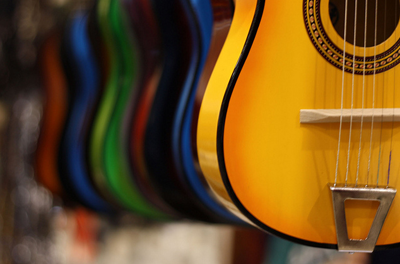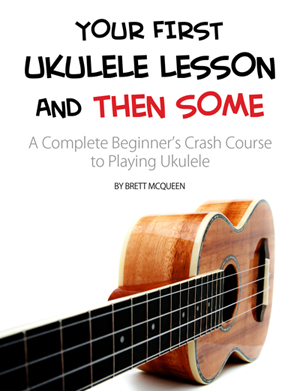Last week, I posted 3 Easy Songs You Can Fingerpick on Ukulele Today.
When you download the sheet music for these songs, you are presented with a musical staff and tablature.
After a couple emails, I realize we’ve looked at how to read music, but one thing we haven’t looked at yet is how to read tabs.
Music tablature, or tab, is a simplified form of musical notation used for stringed instruments like the ukulele.
Most people learn a new piece of music by using tab. Unlike a regular piece of music, tabs show you exactly where to play the notes on the fretboard.
Let’s take a look at some examples of tablature.
Music Tablature Basics
For the ukulele, in a piece of tablature, you will see four lines:
A -----------------------------------------
E -----------------------------------------
C -----------------------------------------
g -----------------------------------------
Each line represents a string on the ukulele. The top line represents the bottom string of the ukulele where the bottom line represents the top string of the ukulele.
When you look at a piece of tab, you’ll see numbers scattered across the different “strings” or lines:
-----3-----------------------------------
-----------0-----------------------0-----
-----------------0-----------0-----------
-----------------------0-----------------
Each number refers to a fret number.
For example, in the piece of tab above, you would pluck the 3rd fret of the bottom string on the ukulele. As we read across the piece of tab, we see that we would then pluck the open E string, the second to bottom string. Then, we would pluck the open C string, the second to top string. Then, we would pluck the open G string, the top string. And so on…
How to Write Chords in Music Tablature
In a piece of tab, you might see all the numbers line up vertically:
-----0-----2-----3-----0-----3-----2-----
-----1-----3-----0-----0-----2-----1-----
-----0-----2-----0-----0-----2-----2-----
-----2-----0-----0-----2-----2-----0-----
When you see this, this means you play a chord. In other words, you play all the notes vertically aligned together.
In the above example, we see the chords played from left to right: F, G, C, Am, D7, and G7.
Other Important Music Tablature Symbols
At this point, you should be able to read tab like a pro, but there are a couple more symbols that we will see on occasion.
Hammer-ons
Hammer-ons are designated by an “h” symbol that separates the two notes.
-----1-------------------
-----1-------------------
-----------2h3-----------
-------------------3-----
In this example, you would pluck the 2nd fret of the second to top string, and then “hammer-on” to the 3rd fret.
Pull-offs
Pull-offs are designated by a “p” symbol that separates the two notes.
-----3p2-----------------
-------------3-----------
-------------------2-----
-------------------0-----
In this example, you would pluck the 3rd fret of the bottom string, and then “pull-off” to the 2nd fret.
Alternative Symbol for Hammer-ons and Pull-offs
Hammer-ons and pull-offs can also be designated by using the “^” symbol.
-----0---------------------
-----------0^3^0-----------
---------------------0-----
---------------------2-----
In this example, you would pluck the open E string, then hammer-on to the 3rd fret, and then pull-off back to the open E string.
Slides
Ascending slides are represented by the “/” symbol, while descending slides are represented by the “\” symbol.
----2/5-----------------
------------3\2---------
-------------------4----
------------------------
In this example, you would pluck the 2nd fret of the bottom string and slide up to the 5th fret. Then, you would pluck the 3rd fret of the second to bottom string and slide down to the 2nd fret.
Bends
Bends are represented by the “b” symbol. An “r” symbol will be used to indicate a bend that returns back to the original plucked note.
----5b6----3-----------------------
----------------3----5b6r5----3----
-----------------------------------
-----------------------------------
In this example, you pluck the 5th fret of the bottom string and bend it to the 6th fret and hold the bend. Then, you would pluck the 3rd fret of the bottom string, and then, the 3rd fret of the second to bottom string.
Next, on the same string, you would pluck the 5th fret of the second, bend up to the 6th fret, and then, return the bend back to the 5th fret. Lastly, you would pluck the 3rd fret.
The Big Downside to Using Tab
As you can see, reading tab is a very intuitive way to learn a song.
However, the big problem is that with tab you don’t get a sense of the rhythm. Meaning, you don’t know when to play the notes written on a piece of tab or how long to hold them in relation to the other notes.
The best way to use tab is in combination with your ear. For example, you’ve heard a song you want to learn how to play on ukulele, and because you know how it sounds, you can use the tab as an aid.
Using tab in combination with reading music is extremely powerful. This is the format in which I posted the fingerpicking songs last week. Be sure to check those out if you want some real practical application for using tabs.


